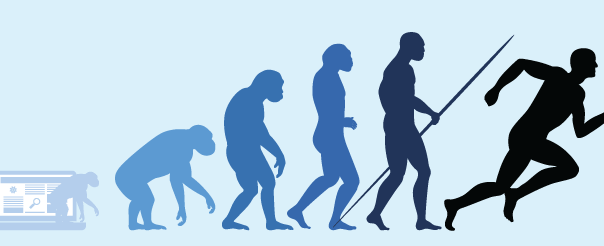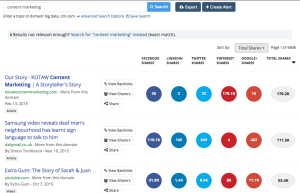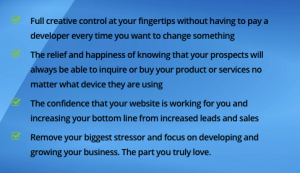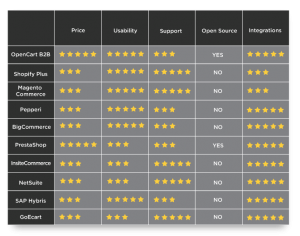
Trends, preferences, and technology change and evolve over time. As we start to think about wrapping up 2016, our B2B web design team sat down to take stock of what we’ve seen over the past several months and analyze how web design has really evolved over the year.
White Space & Clean Designs
White space and bold, clean designs are in high demand as more and more brands are interested in seeing cleaner, less cluttered designs. Rather than considering white space or negative space as “empty,” the web design community is seeing how valuable these spaces are in helping break up content and making it more digestible for the user.
This trend is closely linked to the widespread acceptance and usage of mobile devices for accessing websites. B2C and B2B websites that utilize negative space and clean designs tend to render better on mobile and a variety of devices.
Embrace Motion and Movement
Even five years ago, businesses and marketers were advised to avoid motion and movement on websites because the coding tended to cripple site loading time and cause a poor user experience. In 2016, this is no longer the case and motion is becoming a well-received trend in web design. Even a subtle motion added to the design via JQuery or HTML5 can add interest to a website and make it more engaging. This will likely gain popularity as businesses see how seamlessly it can be integrated into web design, without negative side effects.
Check out a few examples of cool, subtle motion on the Zendesk website and the Adept Source website.
The Gradient Is Back & Better Than Ever
We’ve seen the gradient come and go and it’s definitely back, in new and exciting ways. Now that a gradient can be achieved in web design through CSS, it’s gaining ground as a popular element of the overall design. Adding the gradient via CSS enables web designers to find surprisingly cool ways to include it in the overall layout and design of a website.
Check out how we introduced gradients into the Bop Design website.
Shortened Messaging
One of the more obvious evolutions in web design we’ve seen this year is the shortening and tightening up of messaging on websites. Particularly for B2B businesses, marketers are discovering that they don’t need a whole lot of copy to explain their unique value proposition. This has led to a broad effort in web design to capture people’s attention quickly with shorter messaging. Rather than focusing on long, drawn out explanations and benefits statements, companies are distilling their value proposition to a few words and making that the centerpiece of their web design.
Usability Over SEO
Many progressive SEO managers will tell you that usability and SEO are essentially the same, but SEO still relies heavily on written content as a foundation. Since the end of 2015, we’ve seen a shift in which companies are consciously sacrificing SEO for usability. Rather than prioritizing rising in the search engine rankings, marketers are becoming obsessed with the user experience on the website. We have found they don’t want a lot of content and are looking to make their copy more succinct. In many cases, however, they aren’t sacrificing inbound marketing altogether, as they instead focus on paid search to drive traffic to their website.
A Trend We Love
We always recommend that our clients use custom photography and video whenever possible to set themselves apart from their competitors. In 2016, we’ve seen quite a bit of buy-in concerning custom photography and video and we couldn’t be more pleased. While there can be a significant cost for custom photography and video, it often delivers a high ROI, particularly when the images help to convey their unique value proposition or tell a story about their products or services.
If there isn’t a budget for custom photography or it doesn’t make sense for the industry, we manipulate stock photography to ensure all the images are consistent or have a common element that ties them all together in the web design.
Check out a great example of custom photography on the Melfred Borzall website and integration of custom video on the First Class packaging website. Both of these examples utilize custom photography and video to tell the story behind the products and services they offer and truly differentiate these two firms from their competition.
Accommodate Cross-Device Traffic
Another great evolution that we’ve seen fully develop over the past year is the accommodation of cross-device traffic. It’s not all about mobile anymore, it’s about ALL devices, including mobile devices. Web design is evolving to understand and accommodate the trend of users to view and access websites on more than one device. It’s not uncommon for a user to complete a search on a mobile phone, then later access the same site on a tablet or laptop, then finally view the website on a desktop device.
In 2016, web designers are focusing on making the user experience across all devices seamless by incorporating responsive design elements, including more white space and less copy on each page. At Bop Design, we take it a step further and utilize a quality assurance tool that verifies websites are rendering well on all types of devices and browsers to ensure an optimal user experience.
Why Web Design Is Evolving
So, what is driving these changes and trends in web design?
First, the market is completely saturated when it comes to websites. Most B2C and B2B firms know they must have a website in order to compete and are discovering that in order to compete AND be successful, they must find ways to differentiate themselves.
The second reason behind this evolution is related to how busy our lives have become. People don’t have the time to evaluate 3 – 4 potential partners or companies in depth. Rather, they have to make quick judgment calls on firms in the span of a few seconds. Removing all the clutter from a web design enables a potential client to get the facts they need in the least amount of time.
Creating a strong connection in a short amount of time is the catalyst for many of these design trends and changes.
Trends Fading in Popularity
Since we’ve talked about how web design has evolved in 2016, we also need to address what it has left behind. Features and practices that were all the buzz last year can fade pretty quickly.
Here are a few web design trends that are fading out of popularity.
Content Dense Pages
The critical aspect of SEO has been content and content dense pages. Websites that have a ton of content-dense pages are on the way out. This does not mean that websites are getting rid of written content, they are just shifting from pages that are 1,000 words to shorter, less cluttered pages.
Design for Design Only
There are a handful of web designers that are obsessed with winning awards. While it’s great to win awards for your design work, it’s more important to meet the goals of the website. We can say that we are happy to see that needless design elements are starting to disappear from current web design. Design for design’s sake has no place on most websites, especially not on B2B websites that are looking to generate leads and build relationships.
Slideshow in the Hero Image
It used to be all the rage to have a slideshow featured as the hero image for both B2C and B2B websites. However, the hero image slideshow is becoming less and less popular as users have adapted to scrolling a website to get more information. With the trend moving away from slideshows in the hero image spot, web designers are replacing them with one strong image and just one to two lines of text. Simple. Clean. Direct.
It should be noted that slideshows aren’t disappearing from web design altogether. Rather, slideshows are finding a new place, further down the homepage or on internal pages. We’ve seen great uses of the slideshow for showcasing client testimonials or even a gallery of product images.
Conclusion: Simplify or Perish
If there is one overarching trend we have seen in web design in 2016, it can be summed up as “simplification.” Simplifying messaging, imagery, navigation, layout and the user experience. This is a bit of a simplification (get it?), but is definitely a significant driver in the web design industry right now.
Digital & Social Articles on Business 2 Community(91)
Report Post






